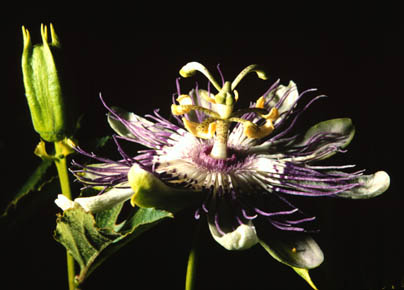
Author: Katherine Salkeld
Common Names:
May Pops, May Apple, The Apricot Vine, Wild Passion Flower
Higher Taxa:
Class:
Order: Passiflorales
Family: Passifloraceae
Tribe: Passifloreae
Genus: Passiflora
Identification:
P. incarnata is one of three Passiflora species that can be found growing wild within the United States. It is predominently found in the southeastern region of the country.

The stems of P. incarnata are smooth or slightly pubescent . They can be erect, repent, or climbing. The leaf blades are palmate and most often three lobed. The leaves are approximately six to fifteen centimeters in length. They are serrated and slightly pubescent.. The petioles are about one to four centimeters in lenght and they have a pair of nectariferous glands near the junction of the blades. The flowers are auxillary and solitary. The sepals are green in color on the back and white on top. The petals can range in color from blueish to white. They are approximately three to four centimeters long. The corona filaments can be white or lavendar in color and are banded with purple. They are about three centimeters long. The fruit of theP. incarnata are about four to seven centimeters long and are green or yellowish in color(Radford, 1968).
Geography:
| Area | Status | Reference |
| N. America-
Continental US;Canada |
yes | Vanderplank, 1996 |
| Eastern North America
US east of Miss.;Ontario and eastern Canada |
yes | Vanderplank, 1996 |
| Southeastern US:
AL,AR,DE,FL,GA,KY,MD,NC,SC,TN,VA,WV |
yes | Vanderplank, 1996 |
| Southern Appalachian States:
AL,GA,KY,MD,NC,SC,TN,VA,WV |
yes | Vanderplank, 1996 |
| Coastal Plain | yes | Duncan and Kartesz,1981 |
| Piedmont | yes | Duncan and Kartesz, 1981 |
| Blue Ridge Mountains | no | Duncan and Kartesz, 1981 |
| Ridge and Valley | yes | Duncan and Kartesz, 1981 |
| Cumberland Plateau | yes | Duncan and Kartesz, 1981 |
| Georgia | yes | Duncan and Kartesz, 1981 |
| Clarke Co. | yes | UGA Herbarium Specimen |
| Sam's Farm | yes | Kate Salkeld, Pers. Obs. |
| old field | yes | Kate Salkeld, Pers. Obs. |
| wetland | ? | |
| woods | ? | |
| 1 Ha. Plot | no | Kate Salkeld, Pers. Obs. |
Natural History:
The P. incarnata prefers soil that is less fertile but well drained. It has been reported that this species can withstand winter temperatures as low as -2F. It is a herbaceous plant the will die to the ground during winter months but will regrow beginning late spring and early summer. The thick, fleshy roots allow this species to survive the cold months of winter(Vanderplank, 1996).
P. incarnata is found widespread across most of the United States. It is predominantly found growing in poor soils on "road and railway embankments, from Virginia to Missouri and south of Florida to Texas, and also in the West Indies"(Vanderplank,1996). To see P.incarnata here in Athens,GA , this beautiful species can be seen throughout the old field at Sam's Farm. Sam's Farm is located just off Highway 78 just past mile marker 16. The intricate lavendar flowers allow them to be easily spotted throughout the field.
References:
Duncan, Wilbur H., and John T. Kartesz. 1981. Vascular Flora of Georgia. The University of Georgia Press. Athens, GA.
Radford, Albert E., Harry E. Ahles, and C. Ritchie Bell. 1968. Manual of Vascular Flora of the Carolinas. University of North Carolina Press. Chapel Hill, NC.
UGA Herbarium Specimans.
Vanderplank, John. 1996. Passion Flowers. The MIT Press. Cambridge, Massachusetts.